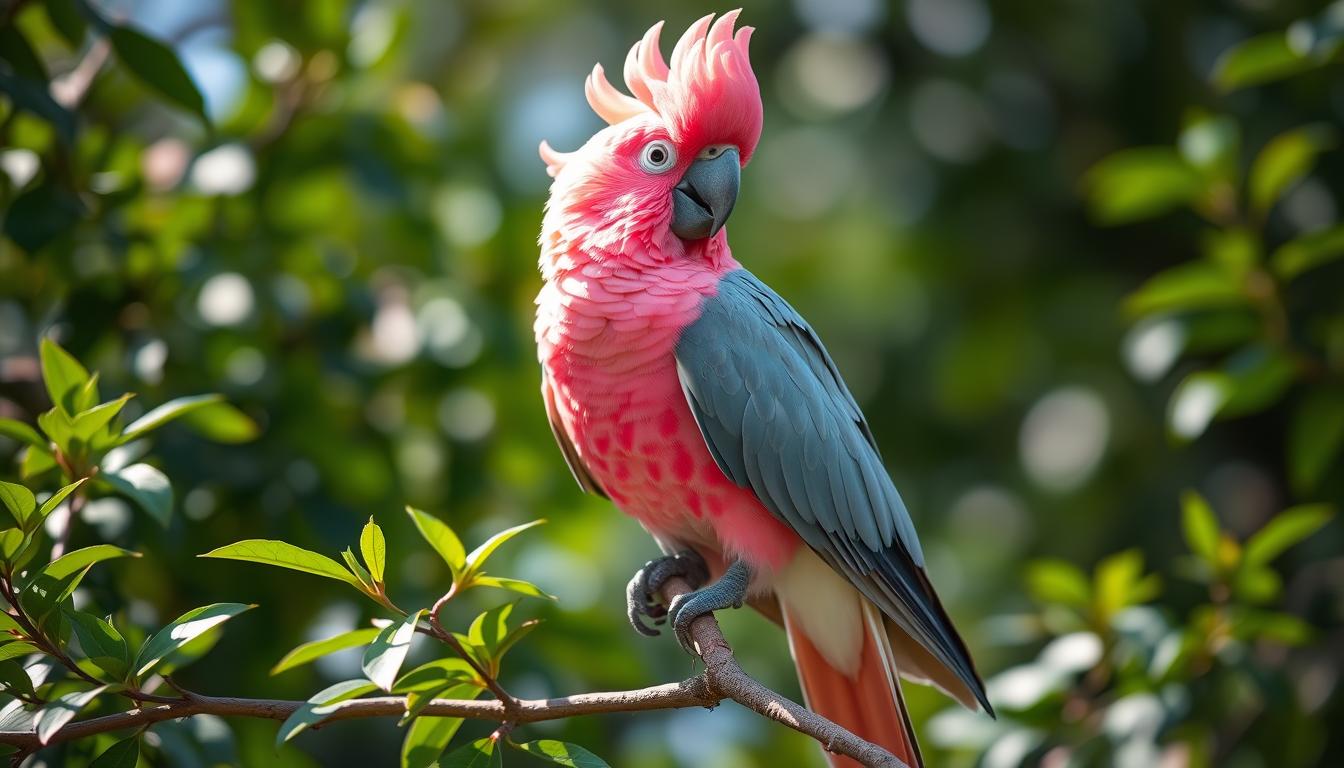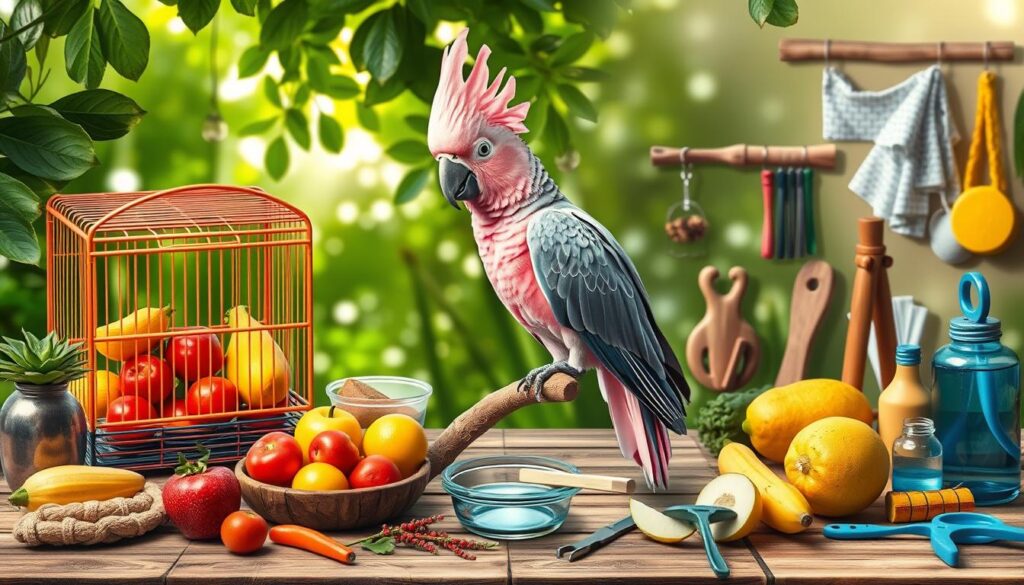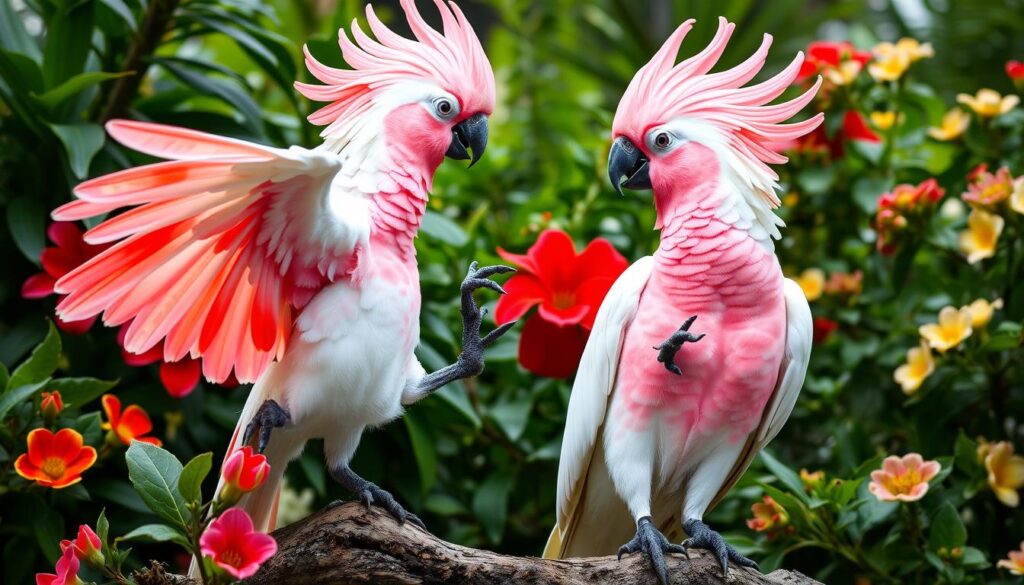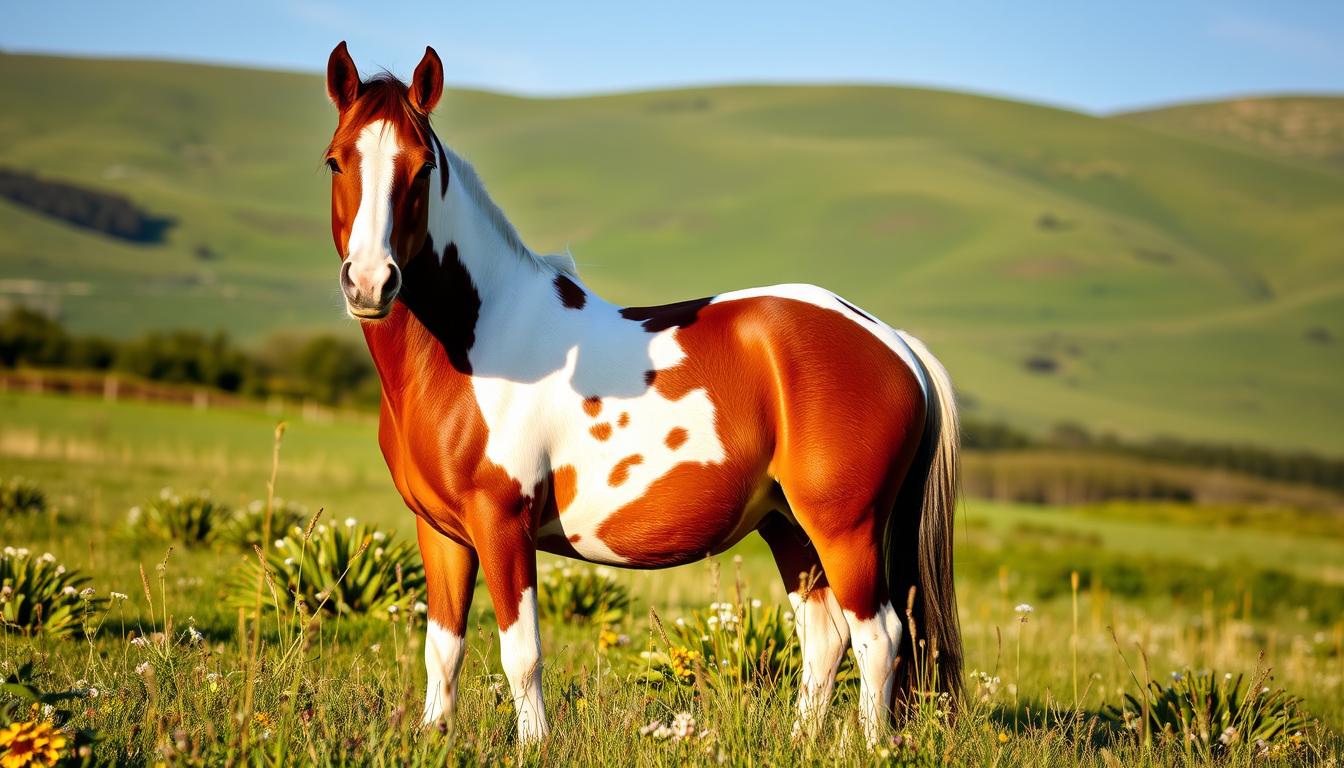Rose Breasted Cockatoo: Charming Pink Parrots

Did you know that the delightful rose breasted cockatoo can live up to 70 years in captivity1? They are known for their stunning pink feathers. These birds are loved by many in the United States for their smarts and loving nature.
Key Takeaways
- The rose breasted cockatoo is a bird with vibrant pink feathers. They are known for their beauty and ability to be great companions.
- With the right care, these birds can live nearly as long as humans. Some can live up to 70 years in captivity, making them lifelong friends1.
- Getting a rose crested cockatoo is a big financial commitment. Prices can go up to $3,0001.
- To keep them healthy, these parrots need a balanced diet and lots of playtime outside their cage. They need at least three to four hours of playtime daily1.
- They need a lot of space and social interaction. You’ll need a big cage and spend time with them regularly12.
- They can mimic sounds and are quieter than other cockatoos. This makes them popular pets2.
Introduction to the Rose Breasted Cockatoo
The Rose Breasted Cockatoo, also known as the galah cockatoo, is loved for its pink breast and friendly nature. It’s important to know about its beauty, needs, and behavior if you’re thinking of getting one. This bird is a big part of the avian world, both in the wild and as pets.
In Australia, the rose breasted cockatoo is a key part of wildlife. It’s not considered endangered, thanks to its wide range and adaptability3. These birds are very social, often living in groups of up to a thousand. This shows how much they love to be around others3.
Knowing the galah cockatoo’s physical traits is key for caring for it. Adults are about 14 inches long and weigh 10-12 ounces. If you’re looking to buy one, make sure you have enough space. A cage of at least 3’ W x 3’ D x 6.5’ H is recommended4.
These birds can live a long time, up to 72 years in captivity. But they usually live between 25 to 40 years34. They need lots of interaction to stay happy and healthy. Without it, they might get depressed or destructive4.
When it comes to food, give your galah cockatoo a mix of birdseed, fruits, veggies, and branches for chewing. This keeps them physically fit and mentally sharp4.
People have loved galah cockatoos for a long time. They’ve gone from being used in recipes to being popular pets worldwide3. Getting a galah cockatoo means adding a piece of history and a lot of personality to your home!
Understanding the Rose Breasted Cockatoo’s Habitat
The rose breasted cockatoo is a famous bird from Australia. It lives in many places, from Tasmania to cities. These birds are very good at changing their homes, making them interesting to study.
Origin and Natural Habitat
The rose breasted cockatoos come from Australia. They live in different places like grasslands and woodlands. They even go to dry areas.
They use things like ponds and troughs for water. This helps them survive in their environment56. They are not in danger, which is good for their home5.
Adaptability to Urban Environments
Rose breasted cockatoos also live in cities. They like parks and gardens, using ponds for food. But, they can damage crops in farms56.
Still, they are very good at living with people. They are loved, but sometimes cause trouble. This shows how adaptable and strong they are.
The Unique Personality Traits of a Rose Breasted Cockatoo
Knowing the rose breasted cockatoo lifespan is key since they can live up to 70 years with proper care. They need a lot of daily interaction to stay happy and healthy7.
These birds show a wide range of behaviors, from mimicking voices to being loud at dawn and dusk7. They may not be as loud as some cockatoos, but their sounds are important. They also need lots of attention from their owners to thrive8.
Here’s a quick look at some key traits and care tips:
| Traits | Behavior | Care Needs |
|---|---|---|
| Playful | Frequently engages in playful activities, such as playing with toys and on their back7 | Requires an assortment of toys and mental stimulation activities |
| Affectionate | Seeks physical affection, favoring neck and head scritches7 | Regular, gentle physical interaction |
| Intelligent | Quick to mimic words and sounds within a short period7 | Continuous vocal and intellectual engagement |
For more detailed care tips and insights into these wonderful birds, check out this resource7. Also, visit Preuss’s Pets for a hands-on learning experience8.
The long lifespan of a rose breasted cockatoo and their lively nature make them a cherished, yet demanding, pet. Each day with a cockatoo is filled with joy and learning, strengthening the bond between them8.
Rose Breasted Cockatoo Care Essentials

Getting a galah cockatoo means you’re ready to learn and care for it well. With the right care, these birds can live for many years. They become a big part of your family.
Dietary Requirements
Feeding your rose breasted cockatoo is more than just seeds. They need a balanced diet to stay healthy. A mix of pellets and fresh salad is key. High-quality pellets should make up most of their food.
Adding fresh fruits and veggies is good for their taste and health. It helps them stay healthy and live longer9.
Choosing the right food, like the right mix of seeds vs. pellets, is important. It helps avoid health problems10.
Cage Size and Setup
The cage size is very important for a rose breasted cockatoo. They need a cage that’s at least 32 x 23 inches. But, the bigger the cage, the better for them.
A big cage helps their health and happiness. It lets them play and exercise. At night, covering the cage helps them feel like they’re in their natural home10.
| Care Aspect | Detail | Importance |
|---|---|---|
| Daily Diet | Balanced mix of pellets and fresh produce | Crucial for nutritional balance |
| Cage Size | Minimum 32 x 23 inches | Essential for physical and mental health |
| Nighttime Setup | Dark and quiet | Mimics natural roosting conditions |
For more tips on caring for your rose breasted cockatoo, check out this resource on cockatoo care9. Also, learn about active geckos as pets. They’re great for those who want easy-to-care-for pets, as explained in this article10.
By focusing on these care points, you’ll make your galah cockatoo happy and healthy. It will be a rewarding experience for both you and your bird.
The Social Dynamics of Rose Breasted Cockatoos
It’s key to understand the social needs of Rose Breasted Cockatoos. They need close relationships with humans and other birds. This is crucial for their happiness and health.
Interaction with Humans and Other Birds
Rose Breasted Cockatoos have a strong bond with humans. This bond is vital for their emotional and mental health. They enjoy interacting with humans, which is important for their growth.
These parrots also love being around other birds. In fact, 57% of them socialize with other parrots. This helps them feel part of a flock, which is good for their social skills11. They can mimic sounds, showing off their ability to play and interact11.
The Importance of Socialization
Rose Breasted Cockatoos need regular social interaction. Without it, they might become destructive or hurt themselves. This is because they need mental stimulation and social interaction.
Playing with them regularly helps prevent these problems. It also keeps their social skills sharp. They need to be with humans and other birds to stay happy and healthy.
| Behavior Trait | Percentage | Implication |
|---|---|---|
| Social Interaction with other parrots | 57% | Indicates a strong need for avian companionship11 |
| Using vocalization in context | 89% | Shows high cognitive abilities to communicate effectively11 |
| Reorganization of words | 65% | Reflects advanced mimicking and learning capabilities11 |
By making these activities a part of their daily life, your Rose Breasted Cockatoo will be happy and well-adjusted. They will thrive on the love and companionship from both humans and other birds.
Breeding Patterns and Lifespan of Rose Breasted Cockatoos

Rose breasted cockatoos have a long life span, up to 40 years. This makes them a symbol of resilience and longevity in the bird world1213.
Their breeding rituals are fascinating. They start breeding at 2 to 5 years old. They can keep breeding into their 20s and beyond, helping keep their numbers stable13. They form long-lasting pairs, often staying together for many years12.
These birds need specific nesting spots. They choose tree cavities or nest boxes in captivity. The nests are lined with wood chips for comfort12.
Here’s a look at their breeding and nesting habits:
- They lay 2 to 3 eggs at a time13.
- Eggs incubate for 19 to 23 days13.
- Chicks leave the nest in 8 to 10 weeks13.
| Dietary Needs | Subspecies Variations | Common Health Concerns |
|---|---|---|
| 1/4 cup of pelleted diet and 1/4 fresh fruits and vegetables daily12 | E. r. roseicapillus, E. r. albiceps, E. r. assimilis12 | Psittacine Beak and Feather Disease, obesity, feather-picking12 |
Conservation efforts are key to keeping their numbers stable. They are listed on Appendix II of the Convention on International Trade in Endangered Species. Knowing about their life span, breeding, and health helps in their conservation1213.
Common Health Concerns and Diseases
When you care for pet birds, knowing about their health issues is key. Avian diseases, feather-picking, and nutritional disorders are big concerns. They need your attention and care.
Nutritional disorders often come from bad diets. For example, birds on all-seed diets can get sick. They might have low blood calcium, leading to muscle tremors and seizures14. Or, they could get upper respiratory diseases from not enough vitamin A14.
| Condition | Common in Species | Symptoms | Possible Diet Related Cause |
|---|---|---|---|
| Psittacine Beak and Feather Disease (PBFD) | African Gray Parrots | Feather loss, beak deformities | Genetic, exacerbated by stress |
| Obesity and associated disorders | Amazon Parrots, Budgies | Weight gain, difficulty flying | High-fat, all-seed diets14 |
| Respiratory Issues | Canaries, Cockatiels | Difficulty breathing, coughing | Airborne pollutants, poor ventilation |
| Arthritis and mobility issues | Older Parrots (e.g., Cocky Boy) | Lethargy, difficulty perching15 | Lack of exercise, poor perch design |
Feather-picking can show up as a sign of stress or physical pain. For cockatoos and others, it might mean they’re stressed, fighting with mates, or not getting the right food14.
Give your bird a diet full of vitamins and minerals. Also, see an avian vet often to keep them healthy. Did you know a specialized avian vet can help a lot? They can tailor treatments and diets, like for Cocky Boy with heart and liver issues15.
Remember, your bird’s health is up to you. Regular vet visits, the right food, and knowing about bird health risks can greatly improve their life.
How to Train a Rose Breasted Cockatoo
Training a rose-breasted cockatoo is a great way to bond with these smart birds. They can mimic voices and are as smart as a 4-5 year-old. It’s important to keep them mentally active and safe16.
Tips for Effective Communication
Start with training treats early on. Use walnut bits and pine nuts, cut small to keep them focused without overfeeding17. When they do something good, praise them with excitement and treats. This makes learning fun17.
Ignore them briefly after bad behavior like biting. This helps stop bad habits. But, do it every time to be consistent16.
Interactive Play and Learning
Playtime is key to keep these lively birds happy. Give them safe toys and chewables like wooden toys or cardboard boxes. These not only entertain but also satisfy their urge to chew16.
Encourage them to mimic voices by repeating words and phrases. Link these to actions or treats to speed up learning. Also, let them watch other birds to learn from them18.
Curious about other petite companions? Discover how to care for Teacup Poodles, they also love attention and regular play.
| Activity | Benefits | Tools Used |
|---|---|---|
| Voice Training | Improves communication skills, provides mental stimulation | Repetitive phrases, training treats |
| Chewable Toys | Satisfies natural chewing instinct, prevents destructive behavior | Wooden blocks, cardboard boxes |
| “Shunning” Technique | Discourages biting, promotes gentle behavior | Consistent behavioral reinforcement |
Training your rose-breasted cockatoo is about more than just discipline. It’s about bonding and keeping their mind active. Each session is a chance to grow closer and keep your bird happy and healthy.
Conclusion
Welcoming a Rose-breasted Cockatoo into your life is a big commitment. They can live up to 70 years with the right care19. These birds need social interaction, a diet rich in veggies and fruits, and lots of daily activity19.
They thrive in a big enclosure, at least 3′ wide by 3′ deep by 6.5′ high19. This lets them stretch their wings and play. With the right care, they’ll bring joy and affection to your family.
When adopting a bird, it’s important to find a reputable breeder or adoption agency. This ensures your new Galah is healthy and happy. Rose-breasted Cockatoos can breed prolifically if cared for well20.
They need a balanced diet, including seeds, veggies, and fruits, to stay healthy20.
Your Rose-breasted Cockatoo will make your home lively and joyful. They’re known for their playful nature, just like in their Australian habitats20. They come in different breast colors, adding to their charm20.
These birds love attention but aren’t too demanding. They make for a wonderful and engaging pet20.
FAQ
What is a rose breasted cockatoo?
How long does a rose breasted cockatoo live?
Where do rose breasted cockatoos come from?
What are some personality traits of the rose breasted cockatoo?
What should I feed my rose breasted cockatoo?
What is the minimum cage size for a rose breasted cockatoo?
How important is socialization for a rose breasted cockatoo?
Are rose breasted cockatoos prone to any diseases?
How can I train my rose breasted cockatoo?
Where can I get a rose breasted cockatoo?
Source Links
- https://www.thesprucepets.com/rose-breasted-cockatoos-390569 – What You Need to Know About the Galah Cockatoo
- https://www.parrotparrot.com/species-guides/rose-breasted-cockatoo/ – Rose-Breasted Cockatoo | Parrot Parrot
- https://en.wikipedia.org/wiki/Galah – Galah
- https://pangovet.com/pet-breeds/birds/galah-rose-breasted-cockatoo/ – Galah (Rose-Breasted) Cockatoo: Info, Personality, Pictures, Food & Care Guide | PangoVet
- https://lafeber.com/pet-birds/get-to-know-the-pink-too/ – Get To Know The Galah: The Pink ‘Too – Pet Birds by Lafeber Co.
- https://www.idahofallsidaho.gov/DocumentCenter/View/5014/Rose-Breasted-Cockatoo – PDF
- https://forums.avianavenue.com/index.php?threads/galah-cockatoos-the-good-the-bad-and-the-ugly-need-info-experiences-please.44102/ – Galah Cockatoos – The Good, the Bad, and the Ugly (Need Info, Experiences Please!)
- https://dallasparrots.com/all-you-need-to-know-about-rose-breasted-cockatoos-a-comprehensive-guide/ – All You Need to Know About Rose-Breasted Cockatoos: – Dallas Parrots
- https://www.viparrot.com/galah-cockatoo/ – Bringing Home a Galah Cockatoo: Tips for new Pet Owners | VIParrot
- https://vcahospitals.com/know-your-pet/cockatoos—general-information – Cockatoos – General Information | VCA Animal Hospitals
- https://www.ncbi.nlm.nih.gov/pmc/articles/PMC9722931/ – A survey of vocal mimicry in companion parrots
- https://www.petplace.com/article/birds/general/choosing-a-rose-breasted-cockatoo – Choosing a Rose-Breasted Cockatoo
- https://susanclubb.com/knowledge-center/bird-species-profiles/20-cockatoos/93-rose-breasted-cockatoo – Susan Clubb – Rose-Breasted Cockatoo
- https://vcahospitals.com/know-your-pet/common-conditions-of-birds – Common Conditions of Pet Birds | VCA Animal Hospitals
- https://birdtricksstore.com/blogs/birdtricks-blog/dealing-with-heart-failure-in-a-galah-rosebreasted-cockatoo?srsltid=AfmBOoplpUbVGyXmbqgdOm27E5ZIqCp_td0Kfzjc6Skw6yrci0iMT7wA – Dealing With Heart Failure in a Rosebreasted Cockatoo
- https://www.parrotforums.com/threads/galah-cockatoo-behavioral-help.76674/ – Galah Cockatoo Behavioral Help!
- https://forums.avianavenue.com/index.php?threads/all-about-galahs-rose-breasted-cockatoos.217398/ – All about Galahs (rose breasted cockatoos)
- https://birdtricksstore.com/blogs/parrot-care-blog/a-touch-training-trick-i-discovered-using-2-birds?srsltid=AfmBOor2xHCNX4e0FzfiZDOuweDqiGpR7i88UFEtzTeKOdK5tlV52wa_ – A Touch Training Trick I Discovered Using 2 Birds
- https://macawfarm.com/rose-breasted-cockatoo/ – Rose Breasted Cockatoo (Galah) Profile, Diet and Nutrition
- https://watchbird-ojs-tamu.tdl.org/watchbird/article/view/3473/3457 – untitled



